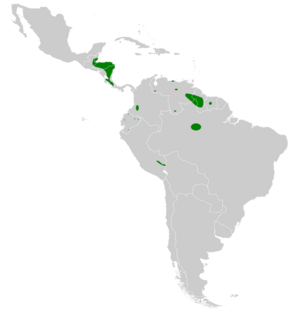White-chinned swift facts for kids
Quick facts for kids White-chinned swift |
|
|---|---|
| Conservation status | |
| Scientific classification | |
| Genus: |
Cypseloides
|
| Species: |
cryptus
|
 |
|
The white-chinned swift (Cypseloides cryptus) is a special kind of bird called a swift. Swifts are known for their amazing flying skills! This bird lives in many places, from Mexico in the north, all the way through Central America, and down into South America. You can find it as far south as Peru and as far east as Suriname.
Contents
About This Swift
What's in a Name?
The white-chinned swift is a "monotypic" species. This means it's the only species in its group. It doesn't have any different subspecies.
Scientists sometimes wonder if it's closely related to other swifts. For example, some think it might be a "superspecies" with the white-fronted swift. Others believe it's more like the sooty swift or Rothschild's swift. Some even think all three might be the same species!
How to Spot a White-Chinned Swift
The white-chinned swift is about 15 centimeters (6 inches) long. It weighs around 35 grams (1.2 ounces). That's about the weight of a few pencils!
Both male and female swifts look alike. They have a dark brown head and cheeks. You might see a small white line just above their eye. Their chin is white, which gives them their name, but their throat is dark brown.
Their back and rump are a blackish-brown color. Their wings and tail are a bit darker. The underside of their body is lighter than their back. The underside of their wings is also lighter than the top.
Where Do They Live?
The white-chinned swift lives in many places, but they are spread out. They don't live everywhere in a continuous line. So far, scientists have only confirmed them nesting in Costa Rica and one spot in northern Brazil.
They have been seen in Mexico and a few other countries. These include Belize, Guatemala, Honduras, Nicaragua, and Panama. There are more sightings in Colombia, Ecuador, Guyana, Peru, Suriname, and Venezuela. Sometimes, one might fly far off course to places like French Guiana or Bolivia. These birds are called "vagrants" when they show up in unexpected places.
Their Home Environment
White-chinned swifts usually fly over evergreen forests. These can be forests on mountains or in lowlands. But they also visit pastures and younger forests that are growing back. They can live anywhere from sea level up to 3,000 meters (9,800 feet) high.
Swift Behavior
Do They Migrate?
Scientists are still learning if white-chinned swifts migrate. It's not yet known if they stay in one place all year or if they travel to different areas depending on the season.
What Do Swifts Eat?
Like all swifts, the white-chinned swift eats insects while flying. They are amazing hunters in the air! Their diet includes many types of insects. They eat bees, wasps, beetles, flies, butterflies, moths, and other small bugs. They often hunt in groups, sometimes with other kinds of swifts.
Reproduction and Life Cycle
Most of what we know about white-chinned swift families comes from Costa Rica. There, they lay their eggs from early May to early June.
They build their nests on rock walls, often near or behind waterfalls. The nests are made of moss, liverworts (small green plants), and mud. They usually place the nest in a crack or under a small overhang. Sometimes, plants hang over the nest, hiding it.
A female swift usually lays only one egg. The egg takes about 30 days to hatch. After the chick hatches, it takes about 55 to 58 days for it to be ready to fly. At the one nesting spot in Brazil, nests were active in July. The nests there were built similarly to those in Costa Rica.
Swift Sounds
White-chinned swifts make different sounds. Some are described as "sharp chips" or "melodious chirping notes." They also make "explosive, staccato clicking notes." Sometimes, they just make single, dry "tick" sounds.
Status of the White-Chinned Swift
The IUCN (International Union for Conservation of Nature) has looked at the white-chinned swift. They have listed it as a species of "Least Concern." This means it's not currently in danger of disappearing.
The estimated population is between 20,000 and 50,000 adult birds. However, this number is thought to be going down. No major threats have been found right now. Scientists say this species is "poorly known." This means we still have a lot to learn about them. They have only been found breeding in a few places.


